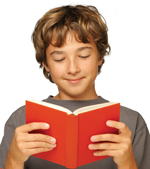 As a young teen, I often borrowed from the “diary” writing model. Today, they’d call me a “memoirist” or, much more likely (and much less charming), a “blogger.”
As a young teen, I often borrowed from the “diary” writing model. Today, they’d call me a “memoirist” or, much more likely (and much less charming), a “blogger.”
No matter. Once I’d read The Diary of Anne Frank, I eagerly adopted her literary technique. I channeled Anne in book reports, creative essays and history papers, using the “Dear Diary” format that had worked so well for her. If writing a report on Gone with the Wind, I’d pen a first-person account of life in the Civil War South. A history paper would inspire a personal journal chronicling D-Day or the Allies’ victory march along the Champs-Elysées.
Some of these academic endeavors worked better than others. The good news? With considerable apologies to Descartes:
I read, therefore I wrote
In last month’s Getting School Ready column, I detailed the way reading books (magazines, too!) shapes — make that transforms — the way young children learn to write. Reading works similar magic for middle-school kids and young teens.
Yes, students can master writing basics in the classroom — topic sentence, introduction, body and conclusion — and cobble together enough respectable reports to plod through the education system. But if you’d rather your child write with a measure of spirit, personality, insight and self-awareness, head directly to the library — and take your teen with you.
Here’s where you discover that selecting books for your teen does not even marginally resemble choosing books for your toddler. For those of you who have actually met a teenager, you’ll immediately recognize the non sequitur in that last sentence: Let’s face it, hardly anyone chooses books for their teen.
What you can do is conduct an unscientific survey of the books your kids spend time with, whether for school assignments or pure sprawling-across-the-bed reading pleasure.
Get in the game
Then pick up one or two of these books and read them. That’s right: Read the latest Sweet Valley High or Camp Confidential or even The Chronicles of Narnia. Some middle-schoolers might feel you’ve treaded on their precious, private print territory, but others will appreciate the fact that mom or dad is showing interest in their literary pursuits.
Reading — or at least getting up close and personal with your kids’ book selections — gives you a way to initiate a dialogue with your teens about a book’s plot, characters and themes. For parents with a brainy bent, those talks can morph into discussions about technique, voice and style: “What descriptive devices does the author use to set a scene?” “What new words have you come across?” “How would you emulate the author’s style?”
At the very least, it beats talking about Lindsay and Britney.
My own daughter loved it when I read her books and shared thoughts and sentiments about classics such as A Wrinkle in Time by Madeleine L’Engle and the Wizard of Oz series. And the truth is, it was rather blissful revisiting these old friends — or in many cases, meeting them for the first time.
It’s all about vampires
In case you’re wondering what today’s kids consider compelling reading, check out Amazon’s top 10 most popular books for teens. I did, and quickly discovered that eight out of the 10 involve vampires. Turns out Stephenie Meyer’s "Twilight" series is so hot, Meyer’s being dubbed the next J.K. Rowling. Her books also dominate the Seattle Public Library’s “Popular Teen Fiction” list, claiming the top five spots. "Twilight" follows the adventures of a teenage girl who moves to Forks (Forks!), Washington, and falls in love with a vampire.
Sound wild? Yes, but . . . it’s a fun read for teens and reasonably entertaining for grownups, too. (Full disclosure: I couldn’t resist finding out what all the brouhaha was about, so I picked up book one — then couldn’t put it down.) And with a little creativity, parents and teachers can use these vampires’ powers for good.
Kids devour romantic fantasy stories, so why not suggest that your middle-schooler write one? Help him structure a fantasy by discussing plot lines, setting and characters. Where will the story take place? In space? Around the corner? How will the characters meet and fall in love?
Then suggest your teen sketch out an outline and structure it according to who the characters are, where they meet and what happens to them. Maybe one of the characters possesses special powers, or acquires them. At some point, the story should deal with problems or crises the characters must overcome.
For those curious to know how Stephenie Meyer comes up with her ideas, check out her Web site at stepheniemeyer.com, and she’ll tell you how it’s done.
Vampire tales can be exhilarating. Exposing your teenager to additional genres? Even better. An ample array of biographies, memoirs, poetry collections, historical novels and classics line library and bookstore shelves (see recommended list). Browse through a collection with your teen. Help him make some choices. And encourage him to read critically and thoughtfully — and with an imagination that knows no bounds.
Linda Morgan, ParentMap associate editor and education writer, is a former writing instructor.
 10 tips for helping your teen become a writer
10 tips for helping your teen become a writer
Ask your teen:
1. What kind of book is this? Romantic novel? Autobiography? Fantasy? Political thriller?
2. Does the author have a message he or she is trying to impart?
3. What kinds of emotions do you feel as you read this book?
4. Who is the reading audience the author has in mind for the book?
5. What kind of research did the author do?
6. What can you find out about the author’s background?
7. What “voice” does the writer use? Narrative? First-person? Humorous?
8. How does the author shape descriptive scenes? What literary devices does he or she use?
9. What other ways could the author have structured the plot? The characters? The ending?
10. What ideas does this book give you if you were to write a story in this genre? What would you do differently?
Great books for young teens
Recommended by Hayden Bass, teen services librarian at the Seattle Public Library
Agnes Parker . . . Keeping Cool in Middle School by Kathleen O’Dell. Getting by in middle school isn’t easy — and Agnes’ strategy to stay invisible might just make things worse. [Realistic fiction]
The Declaration by Gemma Malley. In the year 2099, people have found a way to live forever. But there isn’t room for any more of them. [Science fiction]
Bronx Masquerade by Nikki Grimes. Students in a poetry writing class in the Bronx reveal their thoughts and experiences through poetry. [Poetry, fiction]
Jeremy Fink and the Meaning of Life by Wendy Mass. Just before his 13th birthday, Jeremy receives a box that contains the meaning of life. But first he has to figure out how to open it. [Realistic fiction]
The Year of Secret Assignments by Jaclyn Moriarty. Teens at two rival high schools are assigned to be pen pals to one another, resulting in secret missions, romance and all-out war. [Epistolary fiction]
The Skin I’m In by Sharon G. Flake. Maleeka doesn’t like her friends, or the way she looks. But then a creative writing assignment helps her discover who she really wants to be. [Realistic fiction]
The Absolutely True Diary of a Part-Time Indian by Sherman Alexie. Junior wants to be a cartoonist, but he sees no way to make his dreams come true while living on the reservation. [Realistic fiction]
Harlem Summer by Walter Dean Myers. In 1920s Harlem, 16-year-old Max gets a summer job working for a ground-breaking African American literary magazine. [Historical fiction]
Guts: The True Story Behind Hatchet and the Brian Books by Gary Paulsen. Author Gary Paulsen tells the true stories behind Hatchet and his other survival/adventure books. [Memoir]
Down the Rabbit Hole: An Echo Falls Mystery by Peter Abrahams. Ingrid loves reading Sherlock Holmes novels — -but she never thought she’d end up solving a mystery in her own hometown. [Mystery]
Books that help young writers sharpen their writing skills:
Writing Magic: Creating Stories That Fly by Gail Carson Levine. Newberry Honor author Levine encourages young writers to take writing seriously while still having fun.
Poems from Homeroom: A Writer’s Place to Start by Kathi Appelt. Lots of ideas and exercises to get you inspired about writing.
The Spoken Word Revolution: Slam, Hip Hop & the Poetry of a New Generation, edited by Mark Eleveld. This book comes with a CD to introduce students to the power of spoken-word poetry.
Outspoken! How to Improve Writing and Speaking Skills Through Poetry Performance by Sara Holbrook and Michael Salinger.









